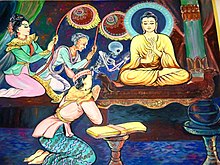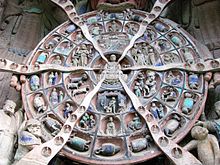Impermanence
This article's factual accuracy is disputed. (April 2022) |

Impermanence, also known as the philosophical problem of change, is a philosophical concept addressed in a variety of religions and philosophies. In Eastern philosophy it is notable for its role in the Buddhist three marks of existence. It is also an element of Hinduism. In Western philosophy it is most famously known through its first appearance in Greek philosophy in the writings of Heraclitus and in his doctrine of panta rhei (everything flows). In Western philosophy the concept is also referred to as becoming.
Indian religions
[edit]The Pali word for impermanence, anicca, is a compound word consisting of "a" meaning non-, and "nicca" meaning "constant, continuous, permanent".[1] While 'nicca' is the concept of continuity and permanence, 'anicca' refers to its exact opposite; the absence of permanence and continuity. The term is synonymous with the Sanskrit term anitya (a + nitya).[1][2] The concept of impermanence is prominent in Buddhism, and it is also found in various schools of Hinduism and Jainism. The term also appears in the Rigveda.[3][4]
Buddhism
[edit]
Impermanence, called anicca (Pāli) or anitya (Sanskrit), appears extensively in the Pali Canon[1] as one of the essential doctrines of Buddhism.[1][5][6] The doctrine asserts that all of conditioned existence, without exception, is "transient, evanescent, inconstant".[1] All temporal things, whether material or mental, are compounded objects in a continuous change of condition, subject to decline and destruction.[1][2] All physical and mental events are not metaphysically real. They are not constant or permanent; they come into being and dissolve.[7]
Hinduism
[edit]The term anitya (अनित्य), in the sense of impermanence of objects and life, appears in verse 1.2.10 of the Katha Upanishad, one of the Principal Upanishads of Hinduism.[8][9] It asserts that everything in the world is impermanent, but impermanent nature of things is an opportunity to obtain what is permanent (nitya) as the Hindu scripture presents its doctrine about Atman (Self).[10][9][11] The term Anitya also appears in the Bhagavad Gita in a similar context.[10]
Buddhism and Hinduism share the doctrine of Anicca or Anitya, that is "nothing lasts, everything is in constant state of change"; however, they disagree on the Anatta doctrine, that is whether Self exists or not.[7] Even in the details of their respective impermanence theories, state Frank Hoffman and Deegalle Mahinda, Buddhist and Hindu traditions differ.[12] Change associated with Anicca and associated attachments produces sorrow or Dukkha asserts Buddhism and therefore need to be discarded for liberation (nibbana), while Hinduism asserts that not all change and attachments lead to Dukkha and some change – mental or physical or self-knowledge – leads to happiness and therefore need to be sought for liberation (moksha).[12] The Nicca (permanent) in Buddhism is anatta (non-soul), the Nitya in Hinduism is atman (Self).[10]
Western philosophy
[edit]| Part of a series on |
| Philosophy |
|---|
Impermanence first appears in Greek philosophy in the writings of Heraclitus and his doctrine of panta rhei (everything flows). Heraclitus was famous for his insistence on ever-present change as being the fundamental essence of the universe, as stated in the famous saying, "No man ever steps in the same river twice".[13] This is commonly considered to be a key contribution in the development of the philosophical concept of becoming, as contrasted with "being", and has sometimes been seen in a dialectical relationship with Parmenides' statement that "whatever is, is, and what is not cannot be", the latter being understood as a key contribution in the development of the philosophical concept of being. For this reason, Parmenides and Heraclitus are commonly considered to be two of the founders of ontology. Scholars have generally believed that either Parmenides was responding to Heraclitus, or Heraclitus to Parmenides, though opinion on who was responding to whom has varied over the course of the 20th and 21st centuries.[14] Heraclitus' position was complemented by his stark commitment to a unity of opposites in the world, stating that "the path up and down are one and the same". Through these doctrines Heraclitus characterized all existing entities by pairs of contrary properties, whereby no entity may ever occupy a single state at a single time. This, along with his cryptic utterance that "all entities come to be in accordance with this Logos" (literally, "word", "reason", or "account") has been the subject of numerous interpretations.
Impermanence was widely but not universally accepted among subsequent Greek philosophers. Democritus' theory of atoms entailed that assemblages of atoms were impermanent.[15] Pyrrho declared that everything was astathmēta (unstable), and anepikrita (unfixed).[16] Plutarch commented on impermanence saying "And if the nature which is measured is subject to the same conditions as the time which measures it, this nature itself has no permanence, nor "being," but is becoming and perishing according to its relation to time.[17] The Stoic philosopher, Marcus Aurelius' Meditations contains many comments about impermanence, such as “Bear in mind that everything that exists is already fraying at the edges, and in transition, subject to fragmentation and to rot.” (10.18)[18]
Plato rejected impermanence, arguing against Heraclitus:[19]
How can that be a real thing which is never in the same state? ... for at the moment that the observer approaches, then they become other ... so that you cannot get any further in knowing their nature or state .... but if that which knows and that which is known exist ever ... then I do not think they can resemble a process or flux ....
Several famous Roman Latin sayings are about impermanence, including Omnia mutantur, Sic transit gloria mundi, and Tempora mutantur.
In arts and culture
[edit]- Akio Jissoji's Buddhist auteur film Mujo (also known as This Transient Life) owes its title to the doctrine of Impermanence.
- Impermanence is the title of a novella written by Daniel Frisano.
- "Impermanence" is the title of the 7th track on For Those That Wish to Exist by Architects.
See also
[edit]References
[edit]- ^ a b c d e f Thomas William Rhys Davids; William Stede (1921). Pali-English Dictionary. Motilal Banarsidass. pp. 355, Article on Nicca. ISBN 978-81-208-1144-7.
- ^ a b Robert E. Buswell Jr.; Donald S. Lopez Jr. (2013). The Princeton Dictionary of Buddhism. Princeton University Press. pp. 47–48, Article on Anitya. ISBN 978-1-4008-4805-8.
- ^ A. C. Paranjpe (2006). Self and Identity in Modern Psychology and Indian Thought. Springer Science & Business Media. p. 172. ISBN 978-0-306-47151-3.
- ^ Martin G. Wiltshire (1990). Ascetic Figures Before and in Early Buddhism: The Emergence of Gautama as the Buddha. Walter de Gruyter. pp. 136 note 14. ISBN 978-3-11-009896-9.
- ^ Richard Gombrich (2006). Theravada Buddhism. Routledge. p. 47. ISBN 978-1-134-90352-8., Quote: "All phenomenal existence [in Buddhism] is said to have three interlocking characteristics: impermanence, suffering and lack of soul or essence."
- ^ Robert E. Buswell Jr.; Donald S. Lopez Jr. (2013). The Princeton Dictionary of Buddhism. Princeton University Press. pp. 42–43, 47, 581. ISBN 978-1-4008-4805-8.
- ^ a b Ray Billington (2002). Understanding Eastern Philosophy. Routledge. pp. 56–59. ISBN 978-1-134-79348-8.
- ^ Katha Upanishad 1.2.10, Wikisource; Quote: जानाम्यहं शेवधिरित्यनित्यं न ह्यध्रुवैः प्राप्यते हि ध्रुवं तत् । ततो मया नाचिकेतश्चितोऽग्निः अनित्यैर्द्रव्यैः प्राप्तवानस्मि नित्यम् ॥ १०॥
- ^ a b Paul Deussen, Sixty Upanishads of the Veda, Volume 1, Motilal Banarsidass, ISBN 978-8120814684, page 283 with footnote 1
- ^ a b c Richard Francis Gombrich; Cristina Anna Scherrer-Schaub (2008). Buddhist Studies. Motilal Banarsidass. pp. 209–210. ISBN 978-81-208-3248-0.
- ^ Max Muller (1884). The Upanishads. Oxford University Press (Reprinted Dover Press, 2012). p. 9, verse 1.2.10. ISBN 978-0-486-15711-5.
- ^ a b Frank Hoffman; Deegalle Mahinda (2013). Pali Buddhism. Routledge. pp. 162–165. ISBN 978-1-136-78553-5.
- ^ This is how Plato puts Heraclitus' doctrine. See Cratylus, 402a.
- ^ John Palmer (2016). Parmenides. Stanford Encyclopedia of Philosophy. Metaphysics Research Lab, Stanford University.
- ^ "Democritus". The Stanford Encyclopedia of Philosophy. Metaphysics Research Lab, Stanford University. 2016.
- ^ Beckwith, Christopher I. (2015). Greek Buddha: Pyrrho's Encounter with Early Buddhism in Central Asia (PDF). Princeton University Press. pp. 22–23. ISBN 9781400866328.
- ^ Plutarch, On the “E” at Delphi
- ^ Marcus Aurelius on impermanencephillipwells.com April 2015 Archived 31 May 2019 at the Wayback Machine
- ^ Cratylus Paragraph 440 sections c-d.
External links
[edit]- The Buddhist Philosophy of Universal Flux (1935) by Satkari Mookerjee
- All About Change by Thanissaro Bhikkhu
- Three marks of existence by Nyanaponika Thera
- Time and Temporality: A Buddhist Approach, Kenneth K. Inada (1974), Philosophy East and West
